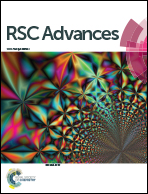Highly efficient FRET from aggregation-induced emission to BODIPY emission based on host–guest interaction for mimicking the light-harvesting system†
Abstract
A novel fluorescence resonance energy transfer (FRET) system based on the interaction of an AIE luminogen (tetraphenylethene, TPE) and BODIPY derivative as the host and guest, respectively, was disclosed. This FRET system worked well for mimicking a light harvesting system with highly energy transfer efficiency up to 93% from aggregation-induced emission to BODIPY emission and shows excellent tolerance to acidic and basic environments.

- This article is part of the themed collection: Editors’ collection: Supramolecular Chemistry


 Please wait while we load your content...
Please wait while we load your content...